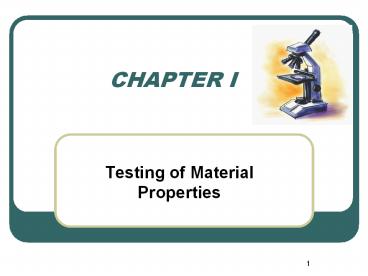Testing of Material Properties - PowerPoint PPT Presentation
1 / 21
Title:
Testing of Material Properties
Description:
CHAPTER I Testing of Material Properties 1.1 Significance of testing materials The testing of materials may be performed with one of the three points below: (1) to ... – PowerPoint PPT presentation
Number of Views:1940
Avg rating:3.0/5.0
Title: Testing of Material Properties
1
CHAPTER I
- Testing of Material Properties
2
1.1 Significance of testing materials
- The testing of materials may be performed with
one of the three points below - (1) to supply routine information on the quality
of a product- commercial or control testing, - (2) to develop new or better information on known
materials or to develop new materials- materials
research, - (3) to obtain accurate measures of fundamental
properties of materials- scientific measurement.
3
Commercial testing
- Commercial testing is concerned with
- checking the acceptability of materials with
respect to the specifications, - control of production.
- Generally, the type of the test has been
specified, standard procedures are used, and the
object is to determine whether the properties of
a material fall within the required limits.
4
Materials research
- Materials research is done in order to
- obtain new understanding of known materials,
- discover the properties of new materials,
- develop meaningful standards of quality or test
procedures.
5
Scientific testing
- Scientific testing is the accumulation of orderly
and reliable informations on the fundamental and
useful properties of materials.
6
What is the difference between experiments and
tests?
- Experimentation means that the outcome is
uncertain, that new insights are to be gained. - Testing is a more defined procedure, with the
limits and results are clear.
7
Materials testing may be carried out on
- 1. Full size structures, members, or parts,
- 2. Models of structures, members, or parts,
- 3. Specimens cut from finished parts,
- 4. Specimens of raw or processed materials,
8
Destructive testing vs Non-destructive testing
- Destructive testing is carried out until the
specimens failure. These tests are generally
much easier to carry out, yield more information
and are easier to interpret than non-destructive
testing - Non-destructive testing is the type of testing
that does not destroy the test object. It is
vital when the material in question is still in
service.
9
Field Tests vs Laboratory Tests
- Field tests usually lack the precision of similar
tests conducted in the laboratory, - However, some tests cannot be made in the
laboratory and others cannot be made in the
field.
10
Precision Accuracy
- Precision repeatability of a measurement
- Accuracy its closeness to the true value
- Exp/ If an instrument consistently gives nearly
identical but wrong readings- precise but
inaccurate - If readings vary considerably but do center about
the true value- accurate but imprecise - Test results should be both precise and accurate!
11
1.2 Standard Specifications Standardizing
Agencies
- Specification A precise statement of a set of
requirements, to be satisfied by a material,
product, system or service. It is desirable that
the requirements, together with their limits,
should be expressed numerically in appropriate
units. - A standard specification for a material is the
result of agreement between those concerned in a
particular field and involves acceptance for use
by participating agencies.
12
Standardizing Agencies Relevant Standards
- Turkish Standards Institute (TSE)-Turkish
Standards (TS) http//www.tse.org.tr/ - American Society for Testing and Materials
(ASTM)- ASTM Specifications http//www.astm.org - International Standards Organization (ISO)- ISO
Standards http//www.iso.org - European Commitee for Standardization (CEN)-
European Norms (EN) http//www.cen.eu
13
1.3 Properties of Engineering Materials
- Principal materials used in construction are
- metals,
- woods,
- portland cement concretes,
- bituminous mixtures,
- clay products,
- masonry materials,
- plastics.
14
Engineering Materials
- The principal function of these materials is to
develop - Strength,
- Rigidity,
- Durability,
- adequate to the service for which they are
intended.
15
An important property- Strength
- The major work of the ordinary materials testing
laboratory has to do with mechanical properties.
mechanical testing - A first requirement of any engineering material
is adequate strength - The term testing machine refers to a machine for
applying loads.
16
Properties of engineering materials-1
Class Property
General Density or specific gravity, Porosity Moisture content Macrostucture Microstructure
Chemical Oxide or compound composition Acidity or alkalinity Resistance to corrosion or weathering
17
Properties of engineering materials-2
Class Property
Physico-chemical Water-absorptive or water-repellent action Shrinkage and swell due to moisture changes
Mechanical Strength Tension, compression, shear and flexure Stiffness Elasticity, plasticity Ductility, brittleness Hardness, wear resistance
18
Properties of engineering materials-3
Class Property
Thermal Specific heat Expansion Conductivity
Electrical and magnetic Conductivity Magnetic permeability Galvanic action
19
Properties of engineering materials-4
Class
Acoustical Sound transmission Sound reflection
Optical Color Light transmission Light reflection
20
TASK
- Visit the Civil Engineering laboratory, notice
where the general equipment is located. - Learn the instruction of the operation of the
compressive strength testing machine.
21
References
- The Testing of Engineering Materials, H.E.
Davis, G.E. Troxell and G.F.W. Hauck, McGraw-Hill
Book Company, 1964. - The Science and Technology of Civil Engineering
Materials, J. F. Young S. Mindess R.J. Gray
and A. Bentur, Prentice Hall, 1998. - Civil Engineering Materials, S. Somayaji,
Prentice Hall, NJ, 1995. - Design and Control of Concrete Mixtures,
Portland Cement Association, USA, 1979. - www.wikipedia.org






























